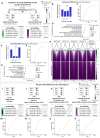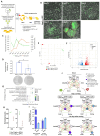An Unbiased Approach to Identifying Cellular Reprogramming-Inducible Enhancers
- PMID: 39684837
- PMCID: PMC11642860
- DOI: 10.3390/ijms252313128
An Unbiased Approach to Identifying Cellular Reprogramming-Inducible Enhancers
Abstract
Cellular reprogramming of somatic cells towards induced pluripotency is a multistep stochastic process mediated by the transcription factors Oct4, Sox2, Klf4 and c-Myc (OSKM), which orchestrate global epigenetic and transcriptional changes. We performed a large-scale analysis of integrated ChIP-seq, ATAC-seq and RNA-seq data and revealed the spatiotemporal highly dynamic pattern of OSKM DNA binding during reprogramming. We found that OSKM show distinct temporal patterns of binding to different classes of pluripotency-related enhancers. Genes involved in reprogramming are regulated by the coordinated activity of multiple enhancers, which are sequentially bound by OSKM for strict transcriptional control. Based on these findings, we developed an unbiased approach to identify Reprogramming-Inducible Enhancers (RIEs), constructed enhancer-traps and isolated cells undergoing reprogramming in real time. We used a representative RIE taken from the Upp1 gene fused to Gfp and isolated cells at different time-points during reprogramming and found that they have unique developmental capacities as they are reprogrammed with high efficiency due to their distinct molecular signatures. In conclusion, our experiments have led to the development of an unbiased method to identify and isolate reprogrammable cells in real time by exploiting the functional dynamics of OSKM, which can be used as efficient reprogramming biomarkers.
Keywords: OSKM; cellular reprogramming; chromatin structure; enhancers; genomics; iPSCs; transcription factors; transcriptional regulation.
Conflict of interest statement
The authors declare no conflicts of interest. The funders had no role in the design of the study; in the collection, analyses, or interpretation of data; in the writing of the manuscript; or in the decision to publish the results.
Figures




References
MeSH terms
Substances
Grants and funding
- #969/Greek General Secretariat for Research and Innovation (GSRI)
- #1567/Greek General Secretariat for Research and Innovation (GSRI)
- Emblematic Action Against COVID19/Greek General Secretariat for Research and Innovation (GSRI)
- 015999/Human Foundation for Research and Innovation
- MIS-05002755/General Secretariat for Research and Innovation (GSRI)
LinkOut - more resources
Full Text Sources
Molecular Biology Databases

